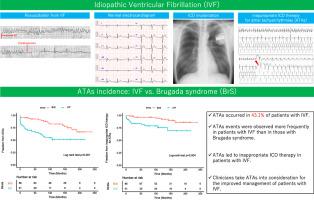Differences in clinical significance of atrial tachyarrhythmias in idiopathic ventricular fibrillation vs Brugada syndrome: A multicenter study
IF 2.5
Q2 CARDIAC & CARDIOVASCULAR SYSTEMS
引用次数: 0
Abstract
Background
Atrial tachyarrhythmias (ATAs) are the primary cause of inappropriate implantable cardioverter-defibrillator (ICD) therapy in patients with idiopathic ventricular fibrillation (IVF) and are associated with decreased quality of life and increased mortality. Nonetheless, the incidence of ATAs in IVF cases has not been clarified.
Objective
The study sought to determine the incidence and clinical significance of ATAs in patients with IVF compared with those with Brugada syndrome (BrS).
Methods
Patients diagnosed with IVF or BrS and receiving ICDs in 6 hospitals were enrolled between February 1997 and July 2020 to compute data regarding the incidence of ATAs, appropriate/inappropriate ICD therapy frequency, and independent predictors of ATAs.
Results
Overall, 137 patients (51 in the IVF group and 86 in the BrS group) were enrolled. ATAs were detected in 22 (43.1%) patients in the IVF group and 17 (19.8%) in the BrS group (P = .006). Inappropriate ICD therapies due to ATAs were more frequently observed in the IVF group than in the BrS group (12 [23.5%] vs 7 [8.1%]; P = .020). Conversely, there was no significant difference in appropriate ICD therapies between the IVF and BrS groups (14 [27.5%] vs 23 [27.1%]; P = 1.000). Cox regression analysis revealed no predictive factors for the development of ATAs in the IVF group.
Conclusion
ATA events were observed more frequently in patients with IVF than in those with BrS, and ATAs led to inappropriate ICD therapy in patients with IVF. Clinicians need to consider the recurrence of not only ventricular arrhythmias, but also the development of atrial arrhythmias for better management of IVF cases.

特发性室颤与 Brugada 综合征房性快速性心律失常的临床意义差异:一项多中心研究
背景房性快速性心律失常(ATA)是特发性室颤(IVF)患者接受不适当的植入式心律转复除颤器(ICD)治疗的主要原因,并与生活质量下降和死亡率增加有关。然而,ATA 在 IVF 病例中的发生率尚未明确。研究旨在确定与 Brugada 综合征(BrS)患者相比,ATA 在 IVF 患者中的发生率和临床意义。方法在 1997 年 2 月至 2020 年 7 月期间,对 6 家医院诊断为 IVF 或 BrS 并接受 ICD 治疗的患者进行登记,计算有关 ATAs 发生率、适当/不适当 ICD 治疗频率以及 ATAs 独立预测因素的数据。IVF组中有22例(43.1%)患者检测到ATA,BRS组中有17例(19.8%)患者检测到ATA(P = .006)。与 BrS 组相比,IVF 组因 ATAs 导致的不适当 ICD 治疗更为常见(12 [23.5%] vs 7 [8.1%];P = .020)。相反,IVF 组和 BrS 组在适当的 ICD 治疗方面没有明显差异(14 [27.5%] vs 23 [27.1%];P = 1.000)。Cox回归分析显示,IVF组患者中没有发生ATA的预测因素。临床医生不仅需要考虑室性心律失常的复发,还需要考虑房性心律失常的发展,以便更好地管理 IVF 病例。
本文章由计算机程序翻译,如有差异,请以英文原文为准。
求助全文
约1分钟内获得全文
求助全文
来源期刊

Heart Rhythm O2
Cardiology and Cardiovascular Medicine
CiteScore
3.30
自引率
0.00%
发文量
0
审稿时长
52 days
 求助内容:
求助内容: 应助结果提醒方式:
应助结果提醒方式:


